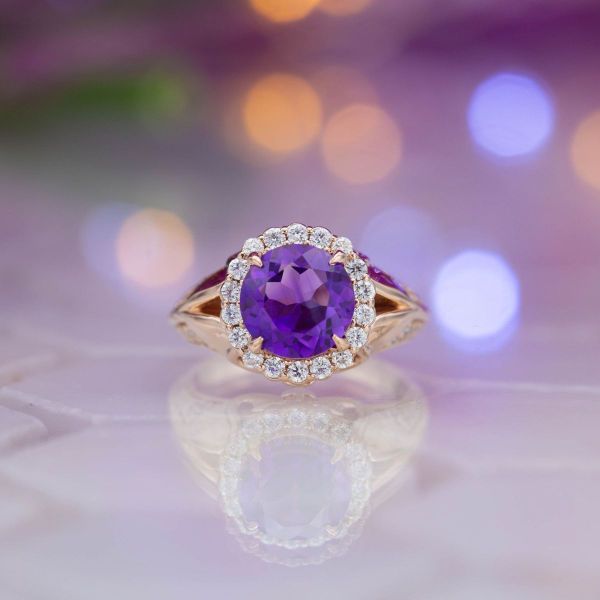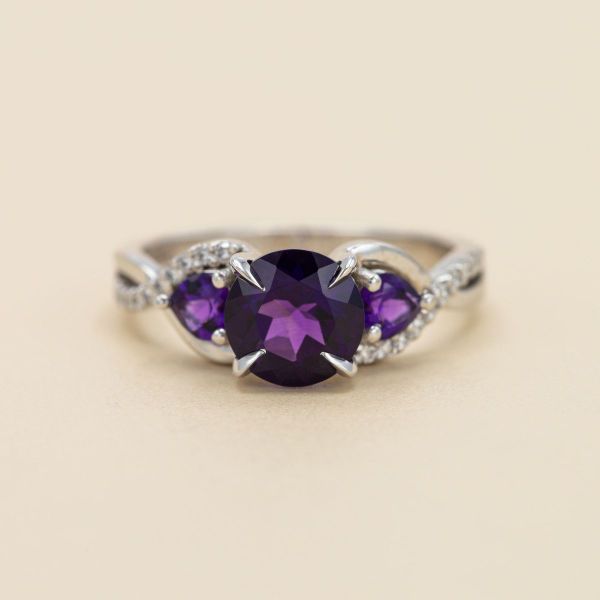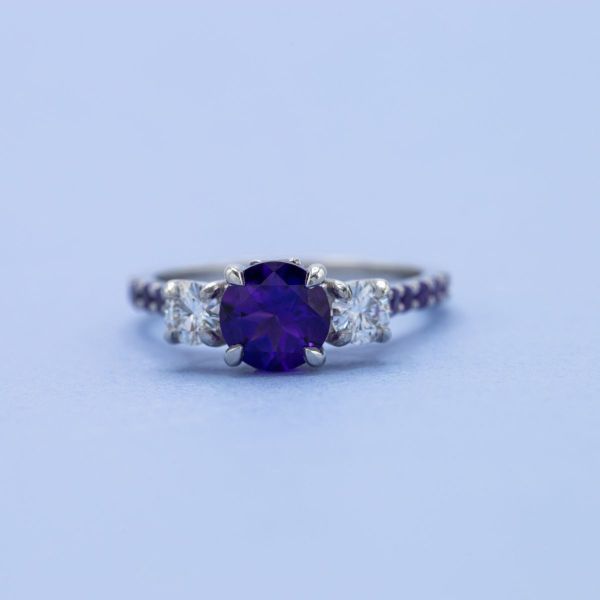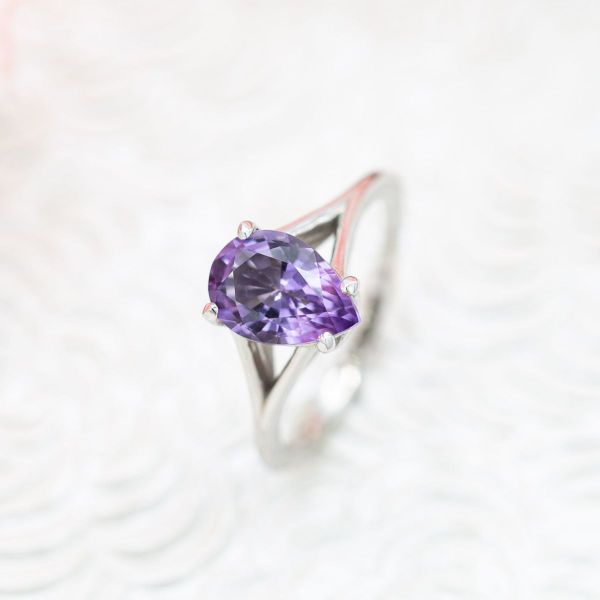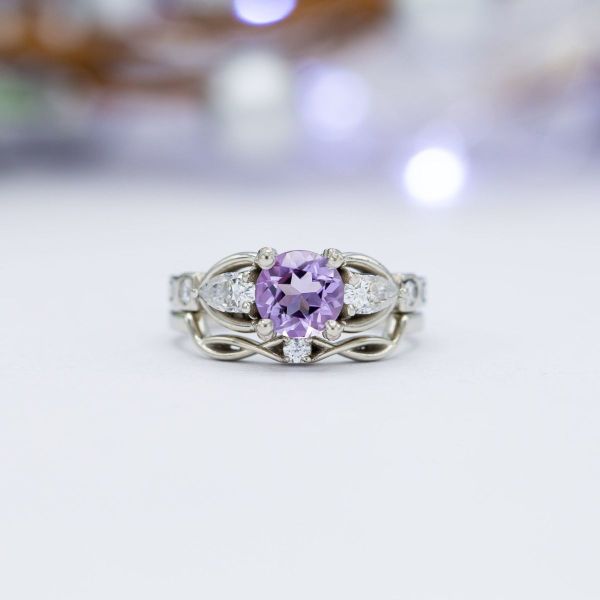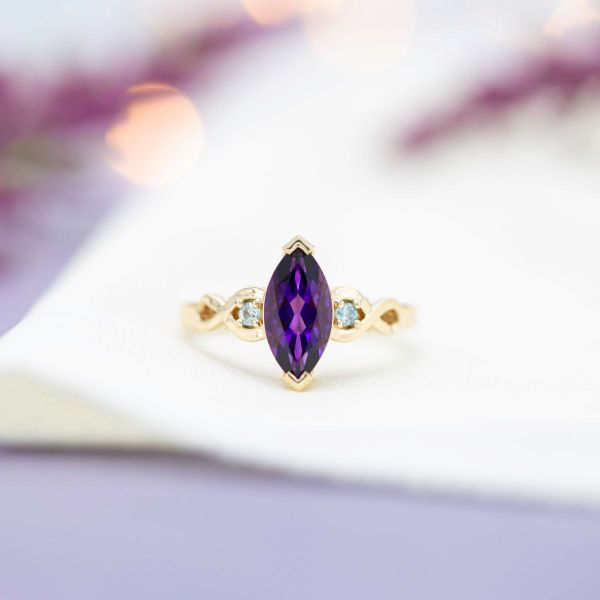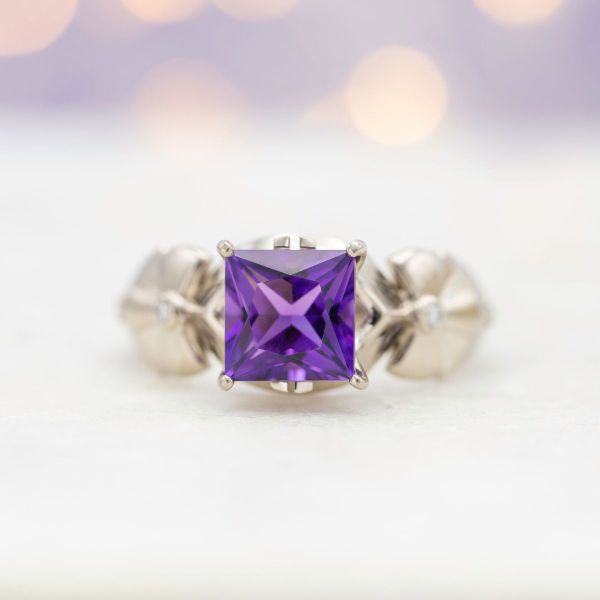Gemstone Knowledge
Exploring amethyst's color
A closer look at the color variances of amethyst.
Rich royal purple
While there are lots of purple stones out there, amethyst is best known for its royal purple hue. Although amethyst’s color can range from light to dark purple, most couples opt for high-quality hues with rich saturation and deep tones. Still, many couples wonder which amethyst color is right for them, and that’s where we come in!
Amethyst is a type of quartz, which gets its color from iron and some other trace elements within the stone as well as irradiation that takes place during amethyst's formation process.
Amethyst color basics: hue, tone, and saturation
To understand amethyst’s signature royal purple, you must first understand the properties of gemstone color: hue, tone, and saturation. We’ve thoroughly covered these topics in our gemstone color guide, but we’ll give you a quick rundown of each as we discuss amethyst’s color.
Let’s start with hue, which basically describes where on the color wheel a stone falls. Is the stone red, green, blue, blue-purple, pink, or something else? We know what you’re thinking: so amethysts are purple, right? Yes! Amethysts can range from light to dark purple, and some stones exhibit red, pink, or brown undertones. But more specifically, while there is some variation in the hue of amethysts, their most well-known color is a royal purple that calls to mind grand halls and jeweled crowns. After all, amethysts were once a prized stone among royals and nobles alike, coveted for their perceived rarity and rich color! Most stones available today have that classic purple color, and while you can find amethysts within some of those purple hue ranges, most variations in color are the result of differences in tone and saturation.
The “finest” hues for amethysts are reddish purple or have violet undertones, but they can’t be too dark to avoid appearing black in dim lighting. Also, notice we’re using quotations here because while these colors are the most sought after, what really matters for the finest stone is it’s the one that’s right for you, whether it’s a rich, dark purple or a light pinkish lavender variety!
While we’re on the subject of light and dark, tone describes the lightness or darkness of a stone’s color. Open (light) toned amethysts allow more light to pass through the stone, giving you a chance to see all of their facets and shadows. On the other hand, darker (closed) toned amethysts can appear almost black and offer only minor glimpses into the heart of the stone! Tone is measured on a scale of 0 to 10, where 0 is colorless, 1 is white, 10 is black–you get the idea. Many couples prefer amethysts with dark tones (around a 7 on the scale) due to their intense color and depth, and these are the amethysts you’re most likely to find as you begin your engagement ring hunting journey. However, some couples love the bright sparkle of a lighter toned stone, and if that’s that case our experts can help you find a lightly toned amethyst that suits your style!
And last—but certainly not least when it comes to amethyst color—saturation is a term that describes the intensity of a stone’s color, and amethysts can have a little or a lot of color. Saturation is one of the most important aspects of choosing an amethyst, because the concentration of color directly impacts how light or dark the purple will be. It’s similar to the difference between adding a single drop of food coloring to one cup of water and then adding ten drops to another cup. The hue—the actual color—of the water in both cups is the same purple, but obviously the water with more food coloring will have a richer and more concentrated appearance. That’s saturation in a nutshell!
So, whether your stone will have that deep, royal purple or a lighter purple color often comes down to each stone’s saturation. Amethysts with strong saturation are plentiful and reasonably affordable, so most of our couples go for that classic highly saturated color without hesitation. But, some still love the idea of a stone with a light or medium saturation for a more pastel aesthetic. Whichever you choose, you can see that describing amethyst’s color isn’t as simple as calling it purple!
Amethyst color and shape variances
Rose de France
If a classic purple amethyst isn’t your thing, have no fear: amethysts with lighter hues have enjoyed a resurgence over the last few decades! One unique coloration, called Rose de France, is a favorite among lovers of light amethysts. Rose de France amethysts have a pale, lilac or pinkish violet hue with lighter tones that are fit for a blushing bride and give you an opportunity to appreciate all of those gorgeous facets and twinkling sparkle. They’re also a top pick for rose gold settings, as their pinkish undertones complement the metal’s rosy hues. Admittedly, there’s nothing different about Rose de France amethysts when it comes to quality–it’s simply a way to describe their sweet, romantic color.
Cabochons
Maybe you’re not into faceted amethysts, and that’s where cabochon varieties come in. A cabochon is smooth and typically unfaceted, so it doesn’t offer the same brilliant sparkle as a faceted stone. However, these cuts have a more mystical appeal that’s great for showing off amethyst’s rich color, and the softer shape pairs well with other luminous stones like pearls and opals. They’re a great choice for fairy queens and witchy women alike, looking stunning in natural or rustic settings that feature brushed metals, opaque or opalescent gemstones, and organic elements like leaves, flowers, etc.
Are amethysts heat treated?
It’s a fair question when it comes to colored gemstones, as some do receive heat treatment to improve their color or clarity. Amethysts can be heat treated to remove color zoning, make dark amethysts lighter in color, or turn the stone into something entirely new. With that being said, amethysts rarely regularly receive heat treatments, but that doesn’t mean quartz can’t be heat treated to make other colored gemstones!
A rule of thumb to follow is that an amethyst of any other color isn’t technically an amethyst. Color variances may include green, yellow, or red-orange, but these are considered prasiolite and citrine respectively. So, you may see prasiolite marketed as “green amethyst” in engagement rings, but it’s actually a different variation of quartz. In short, if it’s not a shade of purple, it’s not really considered amethyst anymore!
Amethysts are also sensitive to high heat and direct sunlight over time, and too much of either can speed up your stone’s color fading from years to mere months. But wait, how is it even possible for the sun to fade a gemstone when a few minutes under its rays can turn some of us into bronzed beauties or miserable red lobsters? Two words: particle physics!
If you place an amethyst in sunlight, photons from the light hit the atoms of the stone, pushing out the color-charged particles–also known as quarks. If you leave the amethyst there, this process will continue until there aren’t any colorful quarks left, causing the stone to fade. So to maintain that quark-y purple hue, it’s important to limit your amethyst’s exposure to sunlight and intense heat! Be sure to remove your ring if you’ll be cooking, cleaning, taking a dip in the hot tub, or heading to the spa before the big day, and store it in a lined jewelry box with a cover away from sunlight.
Conclusion
Amethysts are an ideal engagement ring stone for brides with February birthdays or couples who want a meaningful pick with plenty of romantic symbolism. And with that rich, royal purple hue, we’re sure your amethyst engagement ring will have you feeling like royalty for years to come! As you start your journey, make sure you look at plenty of different amethysts to see which color best suits your dream engagement ring, and our team can help you color match stones if you plan on using multiple amethysts. For more inspiration, take a look at these inspired amethyst designs our couples have come up with in the past!
About CustomMade
CustomMade designs and creates one-of-a-kind, custom engagement rings and fine jewelry. Each piece we create is inspired by you, designed for you, and made just for you.
